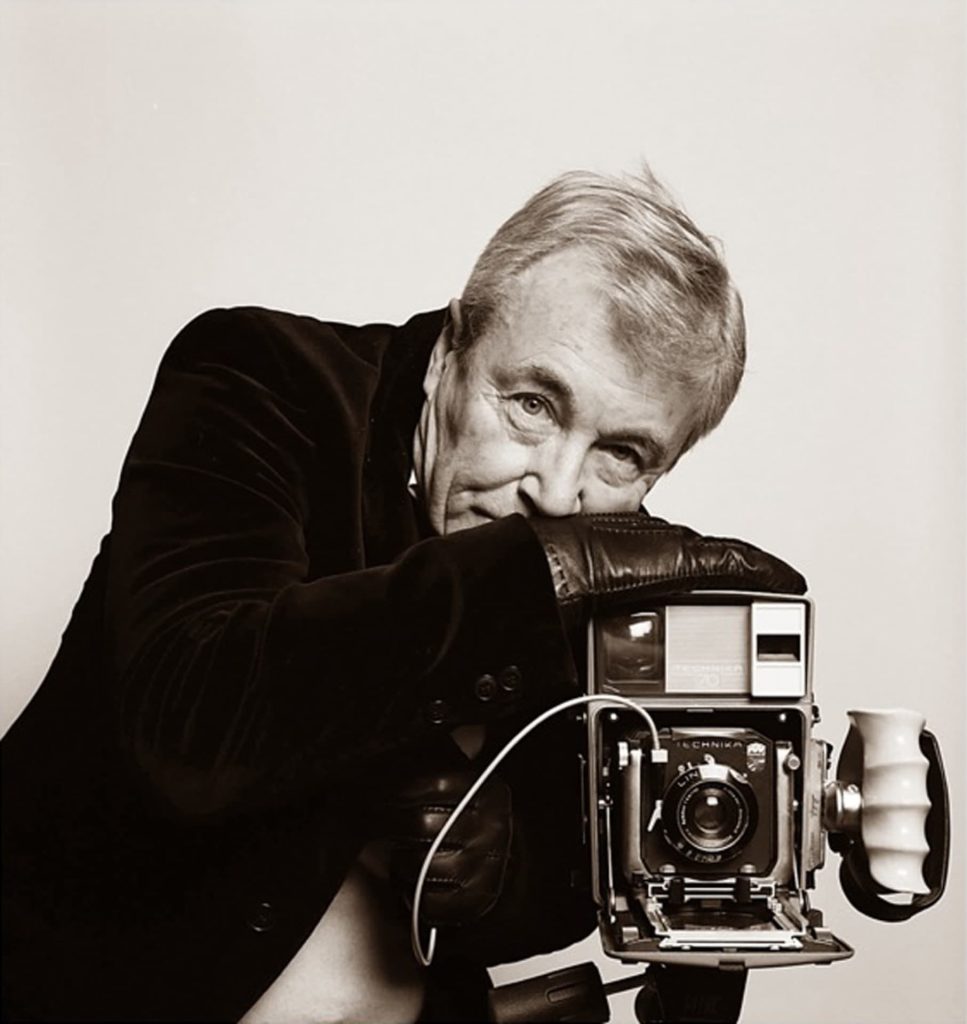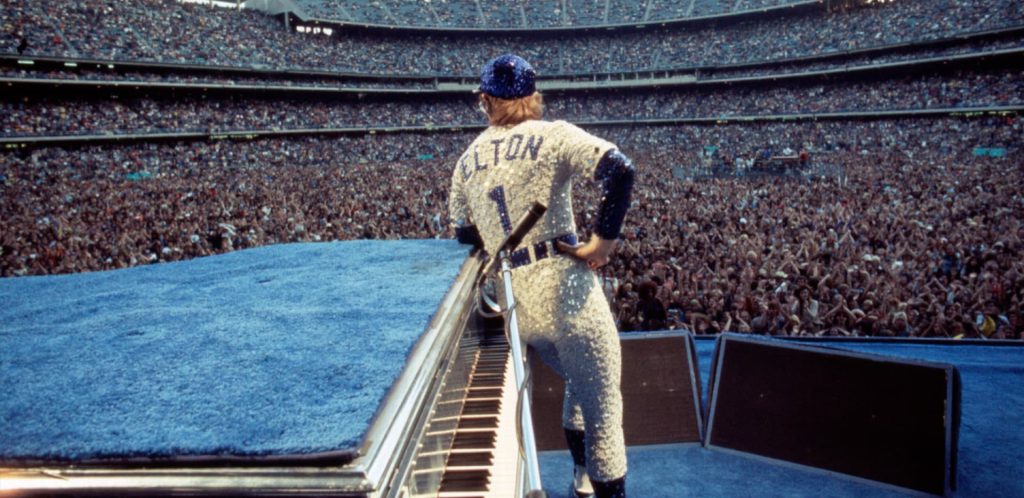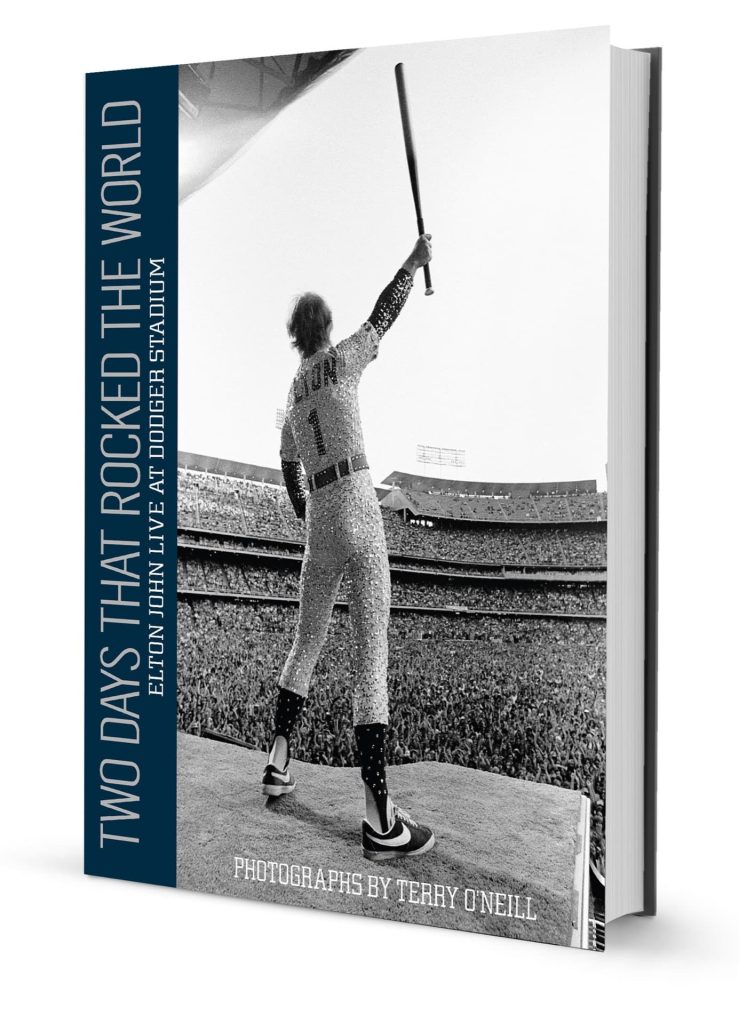Menu
October 25-26, 1975: Elton Knocks It Out Of The Park At Dodger Stadium
On October 25 and 26, 1975, Elton performed two career-defining, sell-out concerts at Dodger Stadium in Los Angeles. By the time it was all over, roughly 110,000 people had crowded into the sporting cathedral to watch Elton perform. Elton didn’t disappoint. Already littering the rock landscape with hit after hit en route to delivering a couple of No. 1 albums per year, his concerts, complete with outrageous costumes and stage antics, were already the stuff of legend.
In honour of the occasion, we spoke with photographer Terry O’Neill, who captured every conceivable moment. His upcoming book, Two Days That Rocked the World, is a one-of-a-kind collection of photographs taken at the two shows and rehearsal the day prior – many rarely seen or never seen before.
The book includes an introduction by Billie Jean King and contributions by band members Ray Cooper, Kenny Passarelli, and Davey Johnstone.

Terry O’Neill (Photo: Emilie Sandy (www.emiliesandy.com))
EltonJohn.com: Do you recall what gear you used and how much film you went through?
Terry O’Neill: I used a proper Nikon S and Kodax 35mm film. I imagine I went through at least 50 rolls over those few days.
EJ.com: How did you prepare for the spontaneity of a concert shoot?
TO’N: I saw Elton perform quite a few times prior, mainly at smaller clubs like the Troubadour. But being able to work these two memorable days at the stadium was different. At the time, they were the largest outdoor concert events ever done by a single artist. I did shoot some film at the rehearsals and sound-checks, and that gave me a little indication of what I would be in for. But those two days and nights, I never really knew what was going to happen.
EJ.com: Did you get a sense from the first show where to stand during the second to get the best shots?
TO’N: I did. At the first show, I didn’t go on stage at all! I was dashing about, trying to capture what was happening at every imaginable angle, climbing stairs, going from side-to-side. On the first night, I went all the way to the top of the back of the stadium so I could get shots of what it looked like from above. I couldn’t believe it when I got there – how enormous the stadium was, what 55,000 people looked like. But even before the shows began, I knew it was going to be special. Elton was at 150% form – all I had to do was press the button. It all unfolded in front of me.
On the second day, I finally plucked up the courage. After one of the songs, Elton introduced me to the audience. He said something like, “You might be wondering who this guy is running around with a camera…it’s Terry O’Neill,” and the crowd cheered. When I went off-stage, my assistant couldn’t believe it! He said, “Elton John just introduced you – you’re immortal!”
EJ.com: Were you tempted to go into the pit (the area between stage and audience)?
TO’N: I went down to the pit to capture some shots but it’s the last place you would want to be – you just don’t want to get caught down there. But Elton allowed me to go anywhere I wanted to. It really felt like I was part of the band.
EJ.com: Can you speak about the challenges of shooting a live concert in an uncontrolled environment – a show that started in daylight and ended in the evening?
TO’N: You have to have a good technique if you are going from day to night or daylight to artificial light. And I didn’t do a lot of live shows prior to this one. By this point, I’ve been working with Elton for a few years and just knew this was going to be something important and it was going to happen very fast. There wasn’t time for me to adjust, I just had to follow and trust his lead.
EJ.com: The shots taken at night of Elton playing piano, looking out towards the audience. How did you get lighting on the crowd?
TO’N: It was just how it was lit; all I had to do was to keep shooting. Remember, I went through 50 rolls or so – and I never knew what was going to be on the film until I developed it. It’s not like it is now where you can see the image the second you take it and adjust accordingly. That’s what is missing from work today; everything is adjusted, timed – controlled. Back in 1975, your eyes saw the shot the second you hit the button and you didn’t see it again until days later [after it was developed].

EJ.com: You can be seen in the Russell Harty documentary standing to the side of the backing singers, with at least 2 cameras hanging around your neck. I assume one had colour film and one had black and white.
TO’N: Yeah – that’s exactly it – one camera was black and white and one colour. Plus a back-up, “just in case.” You don’t want to be the photographer with the broken camera in the middle of the show.
EJ.com: It appears that you took many more black and white photos than colour…was that intentional?
TO’N: I just like black and white more. Always have. I think black and white photography says more, I don’t know why. It has always been my preference.

EJ.com: With the release of this book, have we now seen every image you took at the shows?
TO’N: We went through a lot of images for this book. I’d like to say yes, but you never know what might turn up in the archive. That’s why I wanted to include contact sheets as well as the actual photos – so fans could really have a sense of how much movement there was on-stage. It wasn’t Elton sitting still – it was Elton flying around! There’s a great contact sheet we found where Elton is standing at the top of the piano, the next frame he’s in-flight, the next he’s landed and a second later he’s back at the piano!
I wanted the book to represent that – those moments. We’ve all seen those iconic images of Elton at the piano or on top with the baseball bat – but what I wanted to achieve with the publication of this book is to capture not only Elton, but look at the concert from many angles: the band, back-up singers, guest stars like Billie Jean King, all the incredible fans, backstage. I wanted to give the readers a sense of how wild it all was. What fun we all had.
EJ.com: Did you know at the time that you were taking some iconic photos of Elton that would stand the test of time?
TO’N: No, but I knew those two concerts at Dodger Stadium would stand the test of time. You have to remember – in October 1975, no one was bigger than Elton John. He was like Elvis at the height of his career. It is impossible to try to explain to people today what it was like – numerous number one albums, touring non-stop, recording non-stop, media, press, television…he was everywhere. Elton still is one of the most talented people I’ve ever met and he gave his all at those concerts. He never short-changed people with his shows. So given this opportunity to play at that Stadium – the first musical act to do so since The Beatles – I knew it was going to be special.
EJ.com: Elton’s stage monitors are known for being extraordinarily loud…can you attest to that? Did you temporarily lose your hearing?
TO’N: You are right, it was loud! I never lost my hearing, but I can still hear that concert in my head today.
